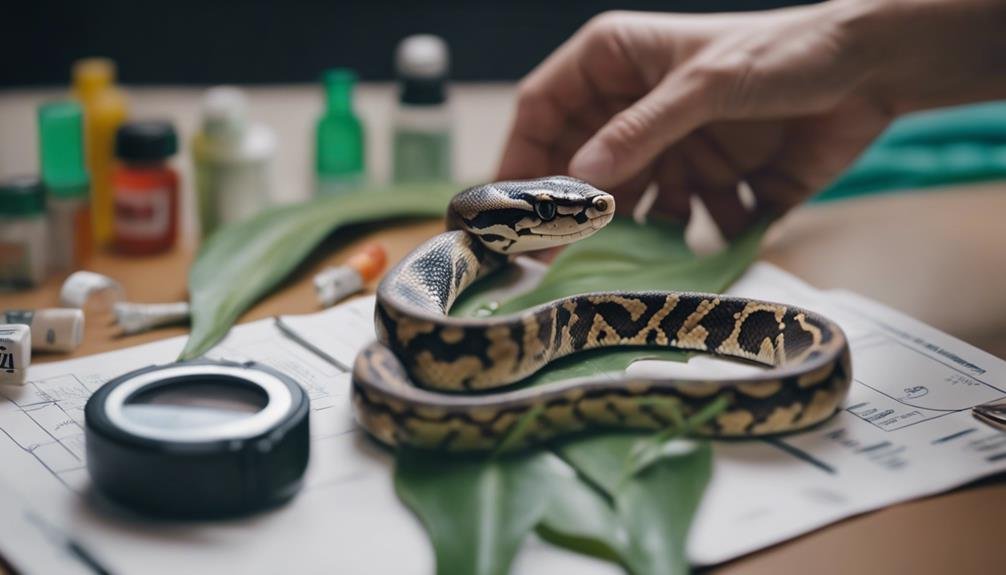You've probably wondered whether ball pythons bite and, if they do, how much it hurts. It's an important concern, especially if you're considering one as a pet or already share your home with one. While these creatures can indeed bite when they feel threatened or confuse your hand for food, the pain is often compared to a quick pinch that rapidly diminishes. However, knowing how to properly treat a bite is vital for preventing infection and ensuring a swift recovery. Let's explore what you should do immediately after a bite and how to minimize the chances of it happening again.
Key Takeaways
- Ball pythons can bite, usually due to mistaking a hand for food or feeling threatened.
- Their bites are nonvenomous and generally not more painful than a minor pinch.
- Immediate cleaning with warm water and antiseptic soap followed by disinfectant application is recommended to prevent infection.
- If bitten, closely monitor the wound for signs of infection such as redness, swelling, or increased pain.
- Seeking medical attention is advised for excessive bleeding, signs of infection, or if an allergic reaction occurs.
Understanding Ball Python Behavior
Many ball pythons are naturally docile, but it's important to understand their behavior to safely interact with them. As pet snakes, these creatures are generally submissive, not showing aggression towards humans. However, grasping their snake body language is key to a harmonious relationship. For instance, if a ball python forms an S shape with its head and neck, it's signaling discomfort or a defensive stance. This behavior is a clear warning sign that you're pushing its boundaries.
Recognizing these signs of defensive behavior not only prevents potential bites but also guarantees your pet feels secure. Remember, ball pythons are solitary by nature, preferring the peace of their own company in their enclosures. This trait means they value their space and may react if they feel it's being infringed upon.
When handling your ball python, always approach with calm and confidence. Quick, unpredictable movements can startle them, leading to defensive reactions. By respecting their space and learning to read their body cues, you'll foster a trusting bond. Keep these handling tips in mind to guarantee both you and your pet snake enjoy a safe, comfortable interaction.
Anatomy of a Ball Python Bite
When a ball python bites, it uses its 30 sharp teeth to grip its prey, a mechanism that's more startling than harmful to humans.
You'll find that treating a python bite is straightforward; washing the area with antiseptic soap suffices, as antivenom isn't needed for these nonvenomous snakes.
Understanding the anatomy of their bite can help you react calmly and manage the situation effectively if it ever happens.
Bite Mechanics Explained
Ball pythons possess around 30 sharp, needle-like teeth designed specifically for gripping their prey securely. Their bite mechanics are fascinating, given these snakes are nonvenomous and lack toxin glands. Instead of injecting venom, their teeth are meant to hold onto their prey firmly until it succumbs. Here's what you need to understand about the anatomy of a ball python bite:
- Nonvenomous Nature: Unlike their venomous counterparts, ball pythons rely on constriction, not venom, making their bites less important to humans.
- Antiseptic Cleaning: Immediate washing of the bite area with antiseptic soap and water is essential to prevent infection.
- The Sensation: The initial shock and the natural reaction to pull away can make the bite feel worse than it is, but remember, it's usually mild and rarely breaks the skin.
Treating Python Bites
If you've been bitten by a ball python, the first step is to calmly wash the wound with soap and warm water. This initial treatment is important to prevent infection at the wound site.
Ball python bites, while not typically severe, can leave minor scratches, puncture wounds, and sometimes bruising due to their inward-curved teeth. After cleaning, check carefully for any stuck teeth in the wound. If you find any, gently remove them and apply a first-aid disinfectant to promote healing.
It's also important to understand the anatomy of a ball python bite to guarantee proper care. If there are signs of infection or unusual symptoms following the bite, don't hesitate to seek medical help. Quick and appropriate treatment of python bites ensures a swift recovery.
Pain Assessment: What to Expect
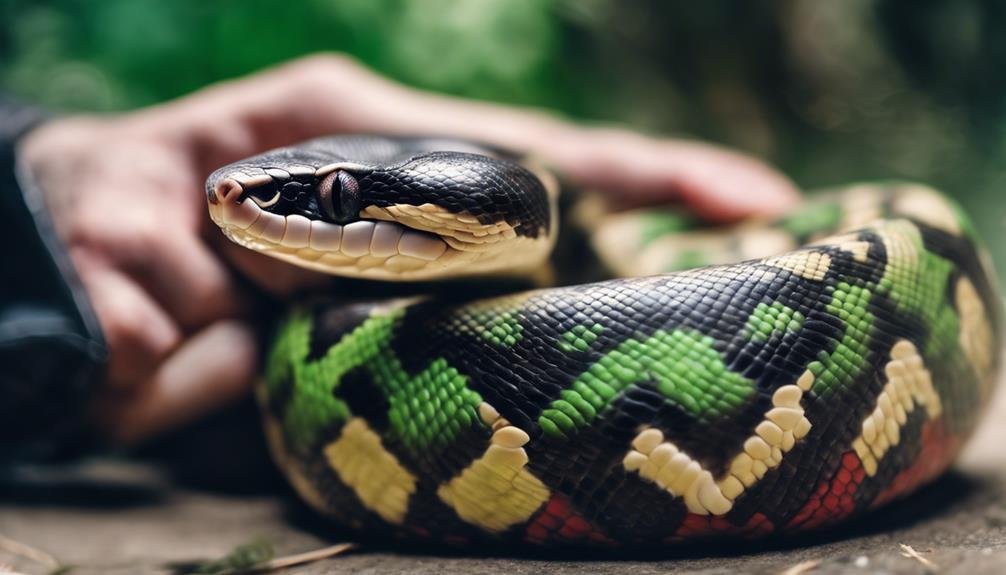

Although a ball python's bite may seem intimidating, it's generally not more painful than a minor pinch or the sensation of stubbing your toe. These snakes have sharp teeth, yet their jaws aren't strong enough to cause serious harm, leading to minor scratches or punctures at the bite site. The discomfort you might experience from a ball python bite is more akin to a brief, sharp surprise rather than enduring pain.
When evaluating the pain from a ball python bite, consider these aspects:
- Location of the Bite: Delicate areas of the body might experience slightly more discomfort due to the sensitivity of the skin.
- Immediate Sensation: Expect a quick, sharp pain that fades quickly, similar to tiny pinpricks.
- Aftermath of the Bite: Minor bruising or curved teeth marks might be visible, causing slight discomfort that can be easily managed with basic wound care.
It's essential to clean the wound thoroughly to prevent infection and monitor the bite site for any signs of complications. If you're ever in doubt, seeking medical advice is always a prudent step. Remember, a ball python's defensive bite is more of a warning than an attack, and proper handling can usually avoid any bites altogether.
Common Reasons for Biting
Understanding why a ball python might bite can help you minimize the risk of such incidents during handling or feeding. One common reason your ball python may lash out is if it mistakes your hand for prey during feeding times. It's easy for these primarily docile creatures to confuse the warmth and movement of your hand with their next meal, leading to a quick bite.
Defensive bites are another scenario you might encounter. If your ball python feels threatened or cornered, it could bite as a natural defense mechanism. This behavior is often a last resort when they feel there's no other way to escape the perceived threat.
Stress and agitation can also lead to biting. If your ball python is stressed due to improper handling or an uncomfortable environment, it may become more aggressive or defensive. Handling them too roughly, too frequently, or in ways that they find threatening can increase the likelihood of a bite.
Immediate Response to a Bite
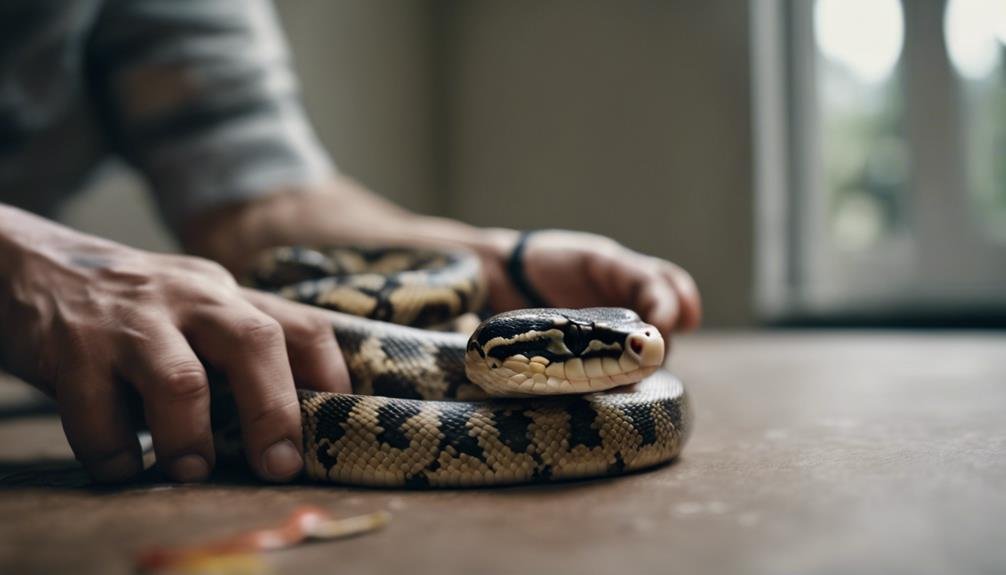

If you find yourself on the receiving end of a ball python bite, it's important to act quickly.
Start by washing the wound with soap and warm water, followed by removing any teeth that may have been left behind.
Applying a disinfectant is your next step to ward off infection, ensuring you're addressing the bite effectively.
Assessing the Bite
When bitten by a ball python, your immediate response should be to wash the wound thoroughly with soap and warm water. While ball python bites are generally mild, feeling akin to tiny pinpricks or a stubbed toe, they can result in scratches, puncture wounds, or bruising, especially in more delicate areas.
To deepen your understanding, consider these points:
- Assess the severity: Ball python bites may look more alarming than they feel, but it's important to evaluate the extent of any scratches or puncture wounds.
- Check for stuck teeth: Occasionally, ball pythons might leave a tooth behind, which requires careful removal.
- Monitor for signs of infection: While rare, any bite can become infected, necessitating close observation for unusual redness, swelling, or pain.
First Aid Steps
After evaluating a ball python's bite, it's essential to promptly provide first aid to minimize any risk of infection and guarantee proper healing.
Begin by washing the bite wound thoroughly with soap and warm water. This step is necessary to prevent infection from setting in. If you notice any stuck teeth in the wound, carefully remove them to avoid further irritation.
Next, apply a first-aid disinfectant such as rubbing alcohol or hydrogen peroxide to the bite area to clean it effectively. Should the bite show signs of infection, swelling, or if the pain persists, it's important to seek medical attention without delay.
Cleaning and Care Post-Bite
Immediately clean the wound with soap and warm water to prevent infections following a ball python bite. This initial step is important in the care process and sets the stage for effective healing. After you've thoroughly cleaned the area, the next steps involve detailed attention to make sure proper wound care and minimize the risk of infection.
Here are three essential steps to follow:
- Check for any stuck teeth: Carefully inspect the wound for any remnants of the snake's teeth. If you find any, gently remove them to avoid further irritation or infection.
- Apply a first-aid disinfectant: Once the wound is clean and free of debris, apply a first-aid disinfectant to kill any bacteria that might be lurking. This step is crucial for preventing infection and promoting healing.
- Seek medical help if necessary: If you're concerned about the bite or if it shows signs of infection, don't hesitate to seek professional medical advice. Better safe than sorry when it comes to your health.
Signs of Infection to Watch For
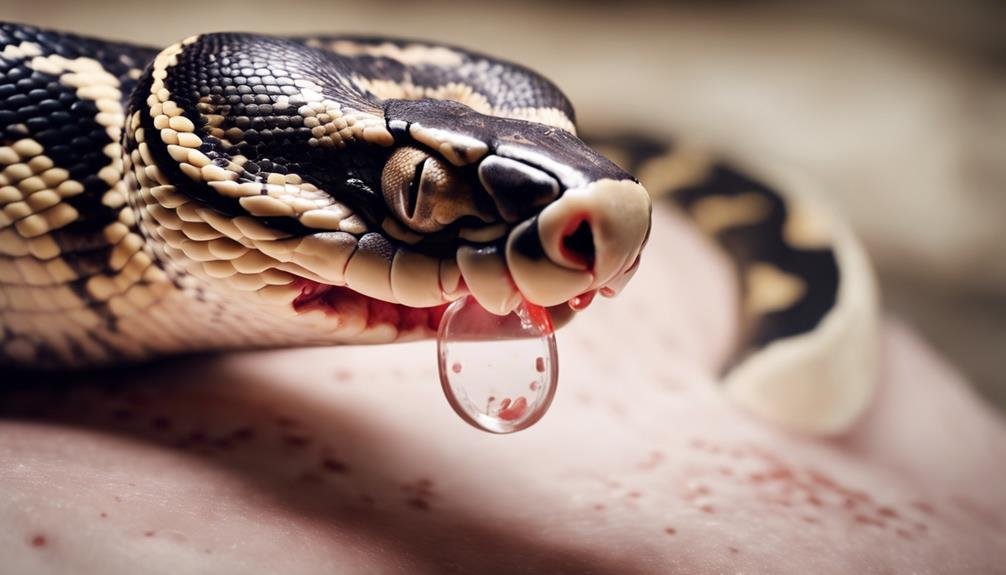

Following the initial steps of wound care, it's important to stay alert for any signs of infection from a ball python bite. Even with proper initial treatment, infections can develop, turning a minor bite into a more serious concern. You'll want to keep an eye out for redness, swelling, or warmth around the bite area. These symptoms can indicate an infection is brewing beneath the skin's surface.
Additionally, increased pain, tenderness, or discharge from the wound are clear signs that something's not right. Infections can escalate quickly, so noticing these early indicators can be key to preventing further complications. Also, monitor for fever, chills, or unusual red streaks spreading from the bite site. These systemic symptoms suggest the infection might be spreading beyond the local area.
Be especially vigilant for any foul odor or pus emanating from the bite, as these are telltale signs of a bacterial infection. If you observe any of these symptoms, it's important not to wait. Although the next steps involve seeking professional medical advice, recognizing these signs early on can have a significant impact on your recovery trajectory.
When to Seek Medical Attention
If you're experiencing severe discomfort or notice any signs of infection after a ball python bite, it's imperative to seek medical attention right away. Though ball pythons are nonvenomous snakes, their bites can still lead to complications if not properly treated. Immediate medical intervention is critical, especially under certain conditions.
Here are three scenarios when seeking immediate medical help becomes a necessity:
- Excessive Bleeding: If the bite from a ball python results in bleeding that doesn't stop with basic first aid, it's a sign that professional medical care is needed.
- Signs of Infection: Watch for swelling, redness, warmth around the bite, or increasing pain. These symptoms indicate a possible infection, transforming a simple bite into a potential medical emergency.
- Allergic Reactions or Unusual Symptoms: Symptoms such as nausea, vision changes, or persistent pain after a bite from a ball python are red flags. If you suspect an allergic reaction, it's vital to treat it as an immediate medical emergency.
Whenever you're in doubt about the severity or the complications arising from a ball python bite, it's always better to err on the side of caution and consult a healthcare provider promptly.
Preventing Future Bites
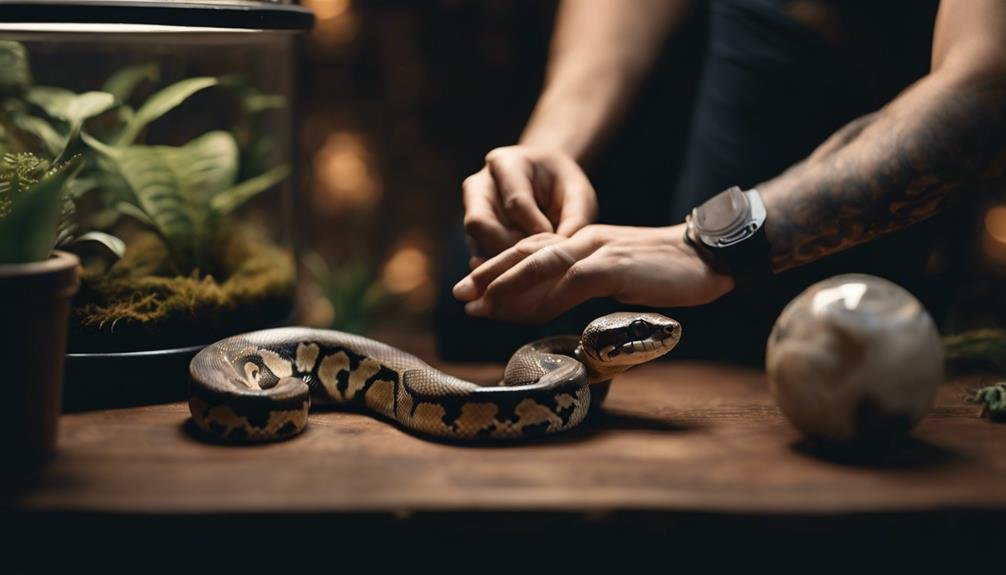

After understanding when to seek medical attention for a ball python bite, it's equally important to focus on preventing future incidents. Recognizing your ball python's defensive body language, such as hissing or coiling into a striking position, is vital. These behaviors signal that your snake feels threatened and may bite in defense. To avoid provoking these reactions, it's advisable not to handle your snake during feeding times or when it's most active at night, as this can increase the risk of bites.
Using feeding tongs when offering food can greatly minimize the chances of your hands being mistaken for prey, thereby reducing the likelihood of a bite. Additionally, keeping your hands clean and free of food smells is essential. Residual scents can confuse your snake, leading to accidental bites due to hunger-driven confusion.
If your ball python shows signs of fear or stress, such as rapid retreats or avoidance behavior, it's best to return it to its enclosure to calm down. This approach not only respects your snake's comfort levels but also prevents defensive bites, ensuring a safer interaction for both of you.
Does Hissing in Ball Pythons Signify an Increased Risk of Biting?
When it comes to ball python hissing behavior, it doesn’t necessarily indicate an increased risk of biting. Hissing is a common defensive response in ball pythons when they feel threatened or stressed. It’s important to understand their body language and give them space to avoid potential biting incidents.
Myths About Ball Python Bites
Let's tackle some of the common misconceptions and exaggerations about ball python bites that you might've heard.
You've likely been told that these bites are incredibly painful or that all ball pythons are ready to bite, but that's not the whole truth.
Understanding the reality behind these myths can help you better appreciate and care for your ball python.
Common Bite Misconceptions
Despite common beliefs, ball pythons often bite only in self-defense or when they feel threatened, debunking the myth that they're aggressively biting without reason. This misconception clouds the truth about these gentle creatures.
Proper understanding and handling can greatly reduce the likelihood of bites, revealing the importance of debunking myths for a harmonious relationship between you and your ball python.
Here are three key misconceptions to reconsider:
- Ball pythons aren't inherently aggressive; their biting is usually a last resort.
- Proper handling and care greatly minimize the chances of being bitten.
- A previous bite doesn't mean a ball python will always be aggressive; with patience, their trust can be regained.
Pain Scale Exaggerations
Busting the myth wide open, ball python bites are far less painful than often exaggerated, feeling more like a sharp pinch than the severe pain some claim. Misconceptions have painted these creatures as bearing a bite that's extremely dangerous and excruciating, which simply isn't true. Remember, ball python bites are usually mild and non-venomous, debunking the myth of their extreme danger and minimal risk to humans.
| Aspect | Myth | Reality |
|---|---|---|
| Pain Level | Excruciating pain | More like a sharp pinch |
| Danger Level | Extremely dangerous | Generally harmless |
| Injury Severity | Causes severe injuries | Rarely causes significant harm |
| Nature | Venomous and poses a high risk to humans | Non-venomous and minimal risk |
| Frequency | Common and aggressive | Rare and typically docile |
Conclusion
To sum up, if you're bitten by a ball python, don't panic. The pain's more like a sharp pinch and fades quickly. Clean the bite with warm water, apply antiseptic, and keep an eye out for signs of infection. If anything looks off, seek medical help.
To avoid future bites, understand your python's behavior and signals of stress or hunger. And remember, most myths about ball python bites are just that—myths. With proper care, bites can be rare and manageable.

